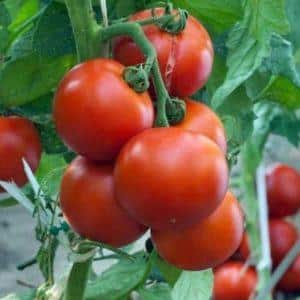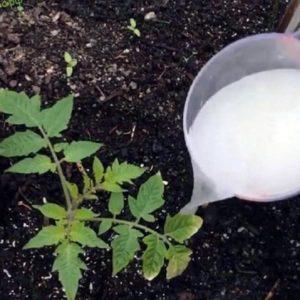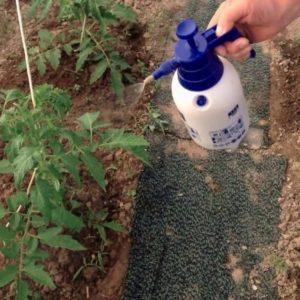How to feed tomatoes during flowering in the greenhouse and fruiting
A pumpkin-sized tomato on your personal plot sounds intriguing, doesn't it? This is exactly the harvest that one American farmer recently received. The weight of the tomato he grew exceeded 3.5 kg. I wonder how often it needed to be watered? It’s a pity that the record holder didn’t share the secret of growing the giant.
Surely, the fruit-bearing plant could not do without fertilizing. We only know that the harvest was obtained in a greenhouse. Let's look at what you can feed tomatoes in a greenhouse during flowering and fruiting to increase productivity.
Signs of element deficiency in tomatoes
 Plants should be fed not only for promotion productivity, but also if they lack nutrients.
Plants should be fed not only for promotion productivity, but also if they lack nutrients.
For example, a lack of bromine affects the leaves. Young tomato leaves and the top of the plant lose color. They turn pale green or yellow, then curl.
Tomatoes may also lack other micro- and macroelements: magnesium, potassium, calcium.
With copper deficiency, the tips of young leaves and shoots turn white. A bronze tint on the leaves will indicate a lack of zinc.
Why do you need to feed tomatoes?
 After planting in the ground, tomatoes are usually fed. After all, transportation and transfer - always stress for plants. During fruiting and flowering, tomatoes also need additional fertilizer.
After planting in the ground, tomatoes are usually fed. After all, transportation and transfer - always stress for plants. During fruiting and flowering, tomatoes also need additional fertilizer.
Experienced gardeners advise feeding tomatoes 3 times - in each of the phases (buds, flowers, fruits).
There are two types of fertilizers:
- root (they are done directly under the root, immediately after watering);
- foliar (above-ground treatment using spraying).
Both types are equally beneficial for plants. And it’s better to alternate them. Although many tomato lovers prefer to do foliar treatments.
 Advantages of foliar feeding:
Advantages of foliar feeding:
- solution consumption is reduced;
- nutrients are absorbed faster through leaves and stems;
- the time for processing plants is reduced.
It is better to do processing by leaves:
- in cloudy weather;
- early in the morning;
- late evening.
You might be interested in: how to water tomatoes in hot weatherto get a good harvest.
If you do not adhere to these rules and feed tomatoes at other times of the day or under other weather conditions, then feeding will not be as effective. Part of the solution will evaporate and will not have time to be absorbed. Plus, plants can get burned from bright sunlight.
Important! Excess fertilizer is just as harmful to tomatoes as not enough.
Purchased drugs
Garden stores offer many types of fertilizers and growth stimulants. You can feed tomatoes using the following preparations:
- series "Gumat" (80, Universal, +7). For 10 liters of water, it is enough to add 1-2 tbsp. drug. It is good to combine the solution with 1 tbsp. mineral fertilizer;
- potassium sulfate, superphosphate, potassium salt. Dilute at the rate of 20 g per liter of water. Water the tomatoes once a week;
- “Kemira”, “Effecton”, “Zdraven”, “Solution” and “Fitosporin”. Dosage rules are contained in the instructions.
If tomatoes are attacked by pests (aphids or caterpillars), you can get rid of them with the help of drugs "Biotin", "Fitoverm" or "Iskra".
Read also: top 20 best ways how pickle garlic.
Folk remedies
You can help plants without resorting to purchased drugs.
Let's look at how experienced tomato growers feed plants using folk remedies without chemicals:
| What to feed | How to do | A comment |
| Boric acid solution | Dilute 0.5-1 teaspoon of boric acid in 10 liters of water. Treat the above-ground parts of plants with a spray bottle | If boric acid is not in solution, but in crystals, dissolve it in hot water. When cold, the crystals will not disperse. Burns may remain on tomato leaves |
| Ash solution with boric acid | Take stove wood ash or ashes from a fire pit. Mix one liter of ash and 10 liters of water. To better dissolve the nutrients, you can boil the mass. Add half a teaspoon of boric acid. Stir and apply foliar feeding. Spray the plants with the resulting solution | The effect is noticeable already on the third day after treatment |
| Yeast starter | Pour 100 g of fresh baker's yeast into three liters of water. Add 50 g of sugar and leave to ferment. When bubbles stop forming, add one glass of ash. Sourdough is used for root feeding | Before feeding tomatoes, it is better to water the soil with plain water. |
| Ammonia solution | Dilute 40 ml of ammonia into 10 liters of water. Pour the solution over the tomatoes | Substance consumption – 0.5 l per bush |
| Milk-iodine solution | Add to one liter of milk:
|
Sugar content and fruit set increase. The risk of plant disease from root rot and late blight is reduced |
| Green herbal infusion | Cooked in a barrel. For 100 liter barrels take:
|
Leave for 14 days, then water the tomatoes 0.5-1 liter per bush |
Note. It is more profitable to buy boric acid and ammonia not in garden stores, but in a pharmacy.
How to feed tomatoes during flowering and fruiting in the greenhouse?
 During tomato flowering, experienced gardeners advise feeding tomatoes in two ways:
During tomato flowering, experienced gardeners advise feeding tomatoes in two ways:
- Kornev. With watering the tomatoes with green fertilizer (infusion).
- Foliar. Spraying tomatoes with a solution of boric acid (for better fruit set in flowers).
When plants enter the fruiting phase, an ash solution is considered the best fertilizer for tomatoes. It can be fertilized both at the root and sprayed on the foliage.
Ash increases the shelf life of fruits (long-term storage) and protects the plant from the development of diseases.
find out in our article, which varieties are in the top 25 sweetest tomatoes.
Conclusion
The fertilizers discussed in this article will help saturate the plants with useful substances, prevent diseases and increase the yield of tomatoes by at least 20%. The most important thing is to maintain proportions.
You can use purchased products as fertilizer or use folk recipes. A good result is achieved by three feedings: during budding, during flowering and during ripening of tomatoes. Wishing you rich and ripe harvests!